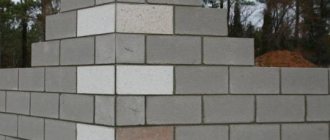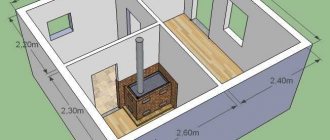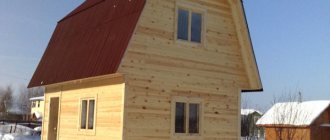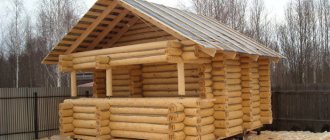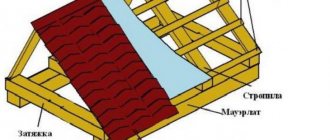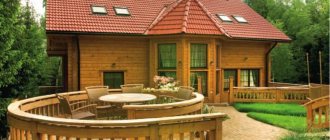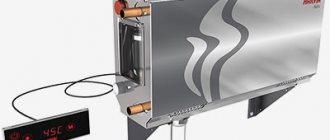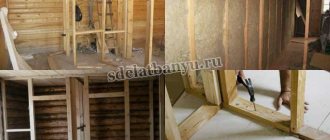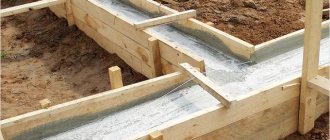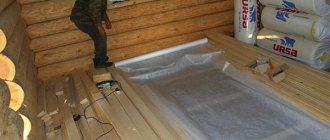Bathhouse made of foam blocks at the dacha: advantages and disadvantages
Advantages of foam concrete blocks:
- High speed of construction;
- During operation, the building does not shrink;
- Suitable for construction on very small plots;
- Possibility of self-construction of a bathhouse without the involvement of professional builders;
- The premises can be used immediately after completion of the work;
- High fire resistance compared to wooden buildings;
- The relatively low mass of the bathhouse, which makes it possible to avoid the use of powerful foundations and makes it possible to build on difficult soils;
- Ease of transportation. If desired, foam blocks can be transported even in a passenger car;
- Relatively low cost of work.
The construction of such a bathhouse will not take much time.
However, a bathhouse made of foam blocks also has a number of disadvantages:
- During operation, condensation will accumulate, which without a well-equipped ventilation system will lead to the appearance of mold and mildew.
- When condensate freezes, structural destruction may occur.
- The need for additional insulation and waterproofing work.
- Relatively low environmental friendliness compared to buildings made of wood.
- Formation of “cold bridges” due to poor quality finishing.
- Shorter service life compared to brick and wooden baths.
Calculation of blocks for a house using the example of a specific object
A private developer can use the most common calculation method discussed below.
Initial data:
- construction project - a two-story house;
- wall height – 3.0 m;
- length and width of the walls – 10x10 m.
In addition to general construction work, an expanded clay concrete block can be used for restoration and insulation of an object, where the amount of material can be calculated in an identical way.
Sequence of actions for calculating expanded clay concrete blocks for a house, calculator:
- the perimeter of the external walls of two floors is determined = 10+10+10+10 = 40 m;
- the total area of the external walls is determined = the sum of the ceiling heights of two floors is multiplied by the perimeter = (3+3)*40 = 240 m²;
- if a standard module 390x188x190 is used, we will take the wall thickness as 390 mm, which corresponds to 0.39 m;
- the volume of the masonry is calculated = the area is multiplied by the thickness of the wall = 240 * 0.39 = 93.6 m³;
- the volume of one module is calculated = 0.39*0.188*0.19 = 0.013 m³;
- the total amount of material is determined = volume of masonry/volume of one block = 93.6/0.013 = 7200 pcs.
The calculation does not take into account the volume of window and door openings. Practice shows that their area during the implementation of any standard project does not exceed 25% of the total area of external walls. If the master wants to calculate this part, he can carry out calculations similarly to the example, removing 5% from the value assigned to the openings, which determines the supply of blocks for battle, scrap, etc.
Subsequent calculations are as follows:
- we calculate 80% of the total area of the masonry = 240*80/100 = 192 m²;
- then we follow standard calculations, the volume of masonry is 74.8 m³, the total amount of material is 5760 pcs.
Knowing the length, height of the partitions and the size of the expanded clay concrete blocks that will be used for their construction, you can calculate the amount of material required for this stage of work. If you wish, you can use a special service - “expanded clay block calculator”
.
When making calculations, it is important to take into account that all parameters must be reduced to the same values. Linear dimensions are taken into account in meters, area - in square meters, volume - in cubic
Building a foundation with your own hands
A bathhouse in a country house is a capital structure, so it is impossible to do without a reliable foundation. Let's look at how to do this with step-by-step instructions.
Which is better
The best option is a shallow strip foundation. You can, of course, use a monolithic slab or a pile foundation, but in this case it will simply be a waste of money.
How to choose the right type of foundation:
How to build
Required tool:
- concrete mixer or container for mixing mortar;
- welding inverter;
- hammer;
- bayonet shovel;
- building level;
- roulette;
- angle grinder (“grinder”);
- Master OK;
- hacksaw;
- rule;
- scrap;
- axe.
Example of a project with an attic and dimensions
You will also need consumables: cutting wheels, electrodes (1.8 mm), nails (60–80 mm).
Click to enlarge
How to build a foundation: step by step
The foundation installation process step by step:
- Clear the area of everything unnecessary, level it, mark the perimeter of the bathhouse using wooden stakes.
- Dig a pit around the entire perimeter of the future bathhouse, 50–60 cm deep and 30–35 cm wide.
- Stick steel pins (rebar) into the corners of the foundation and tie a thick thread to them.
- Using a level, accurately mark the upper horizontal line of the foundation (the thread will serve as a visual boundary).
- Manufacture and weld a steel frame from reinforcement with a diameter of 10–12 mm. It will be enough to place three rows of reinforcement at the top and bottom so that the total height of the foundation is 70 cm. For vertical elements, thinner reinforcement can be used, the step between them should be 1.5 m.
- Put together formwork from boards 25 cm wide around the entire perimeter. In the washing room, provide a hole for the sewer drain in advance by placing a receiving pipe with a diameter of 100 mm.
- Prepare concrete mortar by mixing cement with OPGS in a ratio of 1 to 4.
- Pour the solution into the formwork, align the top edge using the rule according to the level of the tensioned thread.
- Cover the foundation with a tarpaulin or thick burlap, take a break from working until the concrete has completely dried (14–21 days, depending on weather conditions).
A beautiful and elegant building that will decorate your site
At the stage of pouring the base of the bathhouse, a foundation for the bathhouse stove can be constructed in a similar way if it is planned to be built of brick. We also recommend that you familiarize yourself with the projects of brick baths.
Construction of foam block walls
The process of constructing walls from blocks is no different from similar actions when using ordinary bricks. However, due to the fact that the dimensions of the foam blocks are larger, the work goes faster. The best option for building walls is M25 blocks.
What designs of frame houses for baths there are are indicated in this article.
What the design of a bathhouse and a utility block garage looks like is detailed in this article.The article indicates projects of bathhouses made of timber with an attic, as well as the technology for their construction: https://2gazon.ru/postroiki/bani/proekty-iz-brusa-s-mansardoj.html
Advantages of ordering from us
The ISOBLOCK company has a number of advantages that make cooperation with us convenient and profitable. Let's name the most important of them:
- The annual capacity of the enterprise is over 45,000 cubic meters. We are constantly increasing the pace of production thanks to process automation and qualified use of resources.
- Affordable prices for products due to large production volumes and reasonable cost reductions.
- Loading, delivery and unloading of foam blocks throughout Moscow and the Moscow region using the company’s own vehicles of various carrying capacities.
Features of masonry
No matter how well the foundation is leveled, its upper edge will still have some roughness.
To correct this drawback, the first row of walls is laid out using cement-sand mortar, and all subsequent rows are formed using special glue for foam blocks.
Before work, 2–3 layers of rolled waterproofing must be laid on the foundation. You will need the following tool:
- Master OK;
- rubber hammer;
- building level for walls;
- putty knife;
- electric drill with a whisk attachment.
Laying begins from the highest corner of the base, the blocks are laid on the edge, the seams are made as thin as possible.
After the row is formed, the horizontalness is carefully checked using a building level; if necessary, the blocks are leveled by knocking them with a rubber hammer. A metal reinforcing mesh is laid every 2–3 rows. Read about an extension to a wooden tree made of foam blocks here.
How to build walls correctly
Before use, the adhesive mixture for foam blocks is stirred with a whisk for 10 minutes. The glue is applied to the surface of the block in a layer of no more than 5 mm. There is no need to wait for the adhesive mixture to dry completely. During the work, check the horizontality and verticality of each row of blocks. In openings for doors and windows, the blocks are laid on steel beams of appropriate sizes. But what projects there are for two-story bathhouses made of timber can be seen in this article.
Bathhouse with attic:
Information on the purpose of foam concrete blocks
Foam concrete, like aerated concrete, belongs to cellular concrete. Foam concrete block, unlike aerated concrete block, contains many closed pores, which gives foam concrete high levels of moisture resistance and frost resistance.
The foam concrete production process is as follows: Portland cement, sand (with impurity content up to 3 percent), water, foaming agent and polypropylene fiber are mixed.
Pine rosin, bone and flesh glue are used as a foaming agent. Such foaming agents are natural. There are also artificial foaming agents. It is important to know what is included in the composition of foam concrete, since natural materials make the foam concrete block more durable and dense (by creating a denser inter-pore space), and, according to some experts, a number of synthetic additives can cause harm to human health.
Foam concrete blocks can be divided by density:
- structural (D1000-1200);
- structural and thermal insulation (D600-900);
- thermal insulation (D300-500).
Foam concrete blocks are also divided according to their purpose:
- for the construction of external load-bearing walls;
- for insulation of external walls;
- for the construction of internal partitions.
You can find out more detailed information about foam concrete blocks, their use and characteristics in this article.
Seam processing
Seams are the weakest point in the construction of a foam block bathhouse. To prevent heat leaks during operation, only an adhesive composition is used for laying walls, and not ordinary cement mortar. Read about the pros and cons of a house made of foam blocks here.
After completing the construction of the walls, all seams are additionally treated with glue. To apply it, use a narrow spatula.
How to make a utility block with a bathhouse and toilet is detailed in the article.
what it looks like and how to build a house with an attached bathhouse and a gazebo is detailed at this link.
You can see what a bathhouse with a summer kitchen looks like in the photo in this article here:
How to calculate the number of bricks for building a house
There are several calculation options that will be discussed below.
According to the first method, this requires a detailed plan of the future building. Then you need to make the following calculations:
- It is necessary to determine the perimeter (both external and internal) of the walls of the building. This is done for any, even complex, building configuration. All the lengths of the sides of the house are added up.
- The perimeters are multiplied by their height from floor to ceiling.
- Determine the total number of door and window openings and subtract this figure from the number obtained in the previous paragraph. The result of such calculations is the area of the walls. It must be multiplied by the thickness of the parts, and the resulting figure will show how many cubic meters are needed to lay out the walls.
- The resulting figure must be divided by the number of parts per 1 cubic meter calculated above, and the required number of blocks in pieces will be obtained.
Return to contents
How to make a vapor barrier on walls
Foam blocks absorb moisture very well, so installing a vapor barrier on the walls is mandatory. First, the foam blocks are treated with water-repellent compounds on the inside and outside. Then the insulation is attached inside. The best option is basalt or stone wool, as it does not absorb moisture well.
For mineral wool, a special frame is made from wooden beams impregnated with an antiseptic. The fastening step of the beams and their diameter depend on the size of the heat-insulating material; dowels are used as fasteners. Then the finishing finishing material, for example, lining or decorative facing slabs, is attached to the wooden frame.
The insulation is laid in 2 layers to avoid through joints. For vapor barrier, special film membranes are used, and the joints are covered with reflective tape. As additional vapor and thermal insulation, you can use foil penofol, securing it on top of the vapor barrier film.
Roof
The roof of the bathhouse must not only be reliable, but also withstand steam shock from the inside
A gable rafter roof is the best choice for a bathhouse made of foam blocks. The roof is installed after the laying of the stove and chimney is completed.
We recommend detailed material about the rafter system of the attic roof.
Roof installation sequence:
- Place a mauerlat - a beam with a cross-section of at least 180 mm - on the longitudinal walls. Secure it with anchor bolts.
- Make a rafter template: take 2 boards, connect them with the edges to form a kind of “scissors”, nail them.
- Place the free ends of the rafters on the mauerlat, select the desired angle of the slope and fix it by attaching the transverse board with self-tapping screws.
- Take beams 150x500 mm, attach them to the template, make the necessary markings and cut the rafters.
- Fasten the rafters with self-tapping screws (3 pieces for each connection).
- Raise the rafters to the edge of the bathhouse, mark the places where they join the Mauerlat.
- Hem the junctions of the rafters and the mauerlat so that they fit tightly together.
- Connect the rafters and the mauerlat using steel angles, staples, overlays and self-tapping screws.
- Make rafters for the opposite end of the roof using a similar pattern and secure them.
- Pull the cord between the two installed rafters, secure their trusses with oblique supports.
- Cut the remaining trusses and fasten them in increments of 500 mm strictly along the stretched cord.
- Take 100x400 mm boards and secure them with self-tapping screws or nails as roof sheathing at a pitch suitable for subsequent fastening of the insulation.
- Make a rough ceiling from 25 mm thick boards, securing them between the rafters.
- Lay 190 mm thick foam on top.
- Lay the finished attic floor from boards 20–25 mm thick.
- Lay the roofing material (corrugated sheeting or metal tiles).
- Secure the ridge and make a galvanized collar around the pipe.
Do not forget about the ventilation equipment for the interior of the bathhouse, for which leave 2 holes with a diameter of 100 mm at opposite ends of the floor. The gap between the rafter leg and the chimney must be at least 400 mm.
The last stage of wall construction and the reinforced sauna belt:
